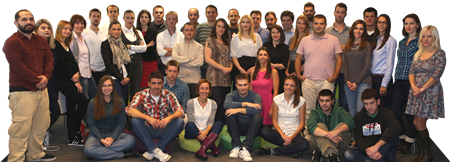John Steinbeck - In Dubious Battle
| Cena: |
| Želi ovaj predmet: | 7 |
| Stanje: | Polovan sa vidljivim znacima korišćenja |
| Garancija: | Ne |
| Isporuka: | Pošta Post Express Lično preuzimanje |
| Plaćanje: | Tekući račun (pre slanja) Lično |
| Grad: |
Beograd-Zvezdara, Beograd-Zvezdara |
ISBN: 014004888X
Godina izdanja: 1986
Jezik: Engleski
Autor: Strani
John Steinbeck - In Dubious Battle
Penguin, 1986
356 str.
meki povez
stanje: prihvatljivo, pečat na prvoj & poslednjoj strani, nalepnica na rikni, otpis iz biblioteke.
In Dubious Battle, published in 1936, follows two main characters, Mac and Jim, through the process of an apple pickers` strike in a small California town. At the beginning of the book Jim joins the Communist Party, and Mac takes him along when he goes to try to agitate the pickers and incite them to strike after the growers` association cuts their wages to fifteen cents. Steinbeck paints a watercolor picture of migrant workers in a small California town during the tough years following the crash and depression of 1929. He shows clearly how the workers lived, how small farmers suffered and how grass-roots organizations, such as the American Communist Party, tried to effect changes that would improve life for the poor workers.
Most of the story takes place in the fictional town of Torgas Valley, California, where the main economy centers around apple orchards and almost all the power in the town is controlled by three people who control the banks and financing companies, the growers` association and the legal system. The time frame of the mid-nineteen thirties is before unionization in the US and right at the beginning of the social movement that followed the Great Depression and preceded WWII. At that time migrant workers were among the lowest paid and most ignored workers, and much of John Steinbeck`s work centered around the lives and culture of this group.
Because of the way Steinbeck explores the characters of migrant workers, their culture and the hard facts of their lives, readers sympathize greatly with both the migrant workers and the `radicals,` agitators and members of the American Communist Party. One gets the feeling that Steinbeck rather identified with both groups, because he points out the broad cultural reaction to the idea of communism in contrast to the reality of the life of these characters. While it is mentioned that Mac gets his `orders` from someone higher up, the origin is never identified, and Mac seems to act quite independently, as do the others who are party members. The derogatory `red` is used often in contrast to what is being done and the explanation of the motivation of the main characters. Though it is never actually stated, readers are given the idea that this is not a Russian plot or a spin-off of the Soviet Communist Party, but rather a grass-roots American movement.
Readers never really learn a great deal about any one character, as the third person viewpoint never actually delves into any character`s mind but only shows what they say and do. Jim is shown at the beginning as leaving his solitary lodgings in a rooming house to begin a new life as a worker for the party, if he is accepted. He is lonely and needs to belong to something. Being a party member empowers him and makes him feel valuable. He and Mac go to Torgas Valley to agitate the workers whose wages for picking apples have been cut. During this process, readers learn the stated and some of the unstated motivations of the individual party members we meet, and we see the growing trend toward seeking social justice.
American, Historical Fiction, Politics, 20th Century, Labor, Strike
Plaćanje pouzećem i postnetom za sada nisu opcija.
Lično preuzimanje je isključivo na Konjarniku uz prethodni dogovor.
Hvala na razumevanju.
Predmet: 18759105







